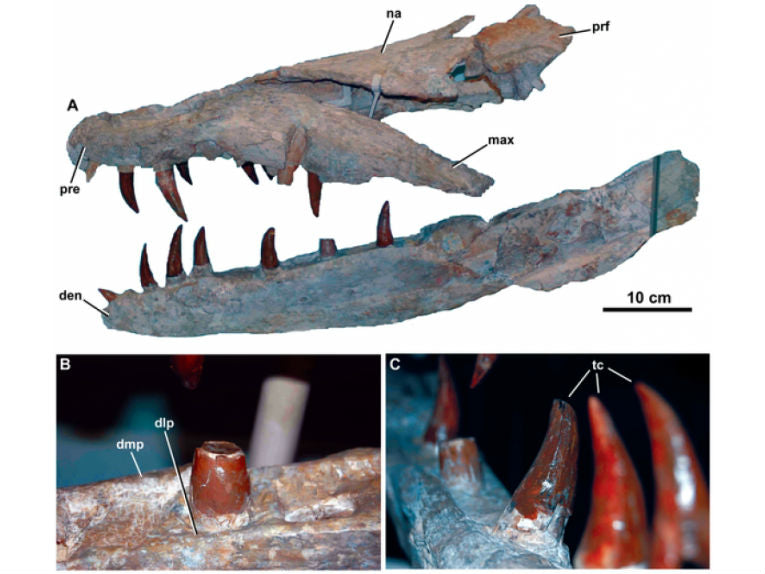The whale-like reptiles have been recognised by several generations of fossil hunters as parallel to our modern mammals. Now we have at least two dolphin-like crocodiles recognised. The orca or killer whale is the biggest dolphin and there are two similar crocodilomorphs at the apex predator level during the late Jurassic period.
According to Mark Young of Edinburgh University, we have mistaken this ancient archosaur line as being stuffy old crocs, just marching along in similar fashion. In fact the jaws and teeth point to a totally different story from that old chestnut. From sucking mouthparts to T. rex type skulls, these crocodylians were very different.
This research shows that crocodiles are not "living fossils", says Mark T.Young in the paper in PLoS ONE. 'The long fossil record of crocodiles show they did many of the things living mammals do today.'
Dakosaurus (the biter-lizard)and Plesiosuchus lived 150 million years ago in the south of Britain and Germany. With mammal-like teeth they ripped up smaller reptiles and fish in two different ways, just like different killer whales do in the North Atlantic. Lack of tooth crown breakage in larger orcas indicates specialist feeding on large prey. The abrasion from fish skin is thought to cause crown breakage so another type of feeding known as suction-feeding is used by those animals that have extensive tooth crown breakage. Suction feeding is defined in a clumsy sort of way as "the creation of negative pressure in the oral or pharyngeal expansion or both to capture, ingest and transport discrete prey items (Werth)."

Credit: © Credit: Young et al., Dmitry Bogdanov / PLoS ONE
Above: Life reconstructions showing the maximum body lengths for the four genera present in Western Europe. The species from top to bottom are: Geosaurus giganteus, Dakosaurus maximus, Torvoneustes carpenteriand Plesiosuchus manselii. The human diver is 1.8 m in height. All l reconstructions are by Dmitry Bogdanov. These four closely related crocodylians lived in western Europe about 152 million years ago. They all had different body lengths and feeding mechanics. These authors reckon they parallel the orca or killer whales.
There are many changes in these ancient creatures, such as the loss of body armour, that help to explain their radiation into many niches. The variety of body size, biting behaviour and dental shapes seems to lead to a super-predator type, involving behaviour likely to use that dentition for big bites! Plesiosuchus could probably eat animals its own size and can now be considered as different from the Dakosaurus genus. Four species of Dakosaurus are recognised, with others currently being assigned to new species, etc, as the mess of old palaeontology is sorted out. These animals were very widespread, it now seems as Russian and Argentinian specimens are likely to be added to the other collections. There might even be a new Mexican relative for those we have so far.
The feeding ecology of fossils is always a difficult area. Dakosaurus is a predator like the killer whales and false killer whales. "We think that Plesiosuchus specialised in eating other marine reptiles, and Dakosaurus was a generalist, probably eating fish as a suction feeder and whatever else it could get hold of, perhaps including the small metriorhynchid Geosaurus,' says Lorna Steel of the Natural History Museum in London.
She contributed as an author along with many scientists from Bristol, Buenos aires, New York (Columbia Universty), The American Museum of Natural History, Colunga and Oviedo in Spain and Stuttgart in Germany. Those teeth could uniquely slice and cut because they needed less energy to penetrate the food. That means they could eat prey with a larger head size than their own.
The authors now place Plesiosuchus in a different genus of its very own. It has a wide snout and serrated teeth with little wear on those crowns. Like big orcas in the Atlantic, it probably fed on large prey, even though the skull wasn't adapted to high stress. The two similar "crocodiles" then occupied completely different niches in their Jurassic ecosystem, just as modern whales live alongside each other but adapt to different diets and food sources.










